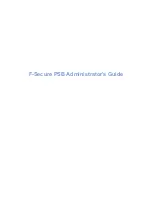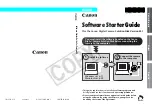
the current class is displayed at the top of the view window.
If you are not currently in a class (or enum or interface), the hierarchy pane is blank and the members
pane shows the symbols in the current file. The name of the current file is displayed at the top of the view
window.
Hover the mouse over the bitmap of any item in the hierarchy or members panes to see a tooltip that
shows the symbol’s signature and scope.
To show or hide the hierarchy pane, use the two buttons located at the top-right of the view window. If the
hierarchy pane is hidden, the members pane is resized to take up the entire space of the window. Use the
size bar to resize either pane.
Use the
Up
/
Down
buttons located to the left of the pane buttons to navigate up or down the class hier-
archy. The
Up
arrow button will allow you to navigate to a child class (derived class or subclass) of the
current class. The
Down
arrow allows you to navigate to a parent class (superclass or interface) of the
current class. When using these buttons to navigate through code, the active buffer will switch to the des-
tination class, and the hierarchy and members panes will update.
To jump to the definition of a class in the code, pushing a bookmark in the process, double-click on any
member or class. Left-click or press
Ctrl
+
Comma
to go back.
Filtering in the Hierarchy Pane
Right-click on a class in the hierarchy pane to display a list of filtering options. You can exclude entire
namespaces or packages, anything above a certain level in the hierarchy, and anything outside of the
current workspace. You can always include any class(es) you have excluded via the "Include" options.
By excluding a class or interface in the hierarchy view, the members of this class or interface are no
longer displayed in the members pane, but they are still visible in the hierarchy as gray text.
Select
Show in Symbol Browser
to jump to the class in the symbol browser.
Class Exclusion Manager
The Class Exclusion Manager, accessed by right-clicking on a class in the hierarchy pane, displays a list
of any currently excluded classes, interfaces, namespaces, and packages. Exclusions are kept on a per-
workspace basis.
Figure 6.2. Class Exclusion Manager Dialog
Class View
84
Содержание Corev3.3 for Eclipse
Страница 1: ...Think Slick Corev3 3 for Eclipse...
Страница 2: ......
Страница 3: ...SlickEdit Core v3 3 for Eclipse...
Страница 5: ......
Страница 6: ......
Страница 14: ...xii...
Страница 20: ...xviii...
Страница 22: ...xx...
Страница 23: ...Chapter 1 Introduction 1...
Страница 41: ...Chapter 3 User Interface 19...
Страница 61: ...Chapter 4 User Preferences 39...
Страница 80: ...BODY BODY HTML HTMLEOF Restoring Settings on Startup 58...
Страница 82: ...60...
Страница 83: ...Chapter 5 Context Tagging 61...
Страница 97: ...Chapter 6 Editing Features 75...
Страница 124: ...Code Templates 102...
Страница 187: ...The finished code is shown as follows Figure 6 24 Dynamic Surround Example 4 Dynamic Surround 165...
Страница 238: ...Figure 6 49 Test Parsing Configuration Example 1 C Refactoring 216...
Страница 240: ...Finally the following example shows a test resulting in no errors or warnings C Refactoring 218...
Страница 241: ...Figure 6 51 Test Parsing Configuration Example 3 Reviewing Refactoring Changes 219...
Страница 250: ...228...
Страница 251: ...Chapter 7 Language Specific Editing 229...
Страница 275: ...Java Refactoring See Java Refactoring for information about Java refactoring in SlickEdit Core Java Refactoring 253...
Страница 328: ...306...
Страница 329: ...Chapter 8 Tools and Utilities 307...
Страница 334: ...6 Click Save The Save Multi File Output dialog box opens Figure 8 3 Save Multi File Output Dialog DIFFzilla 312...
Страница 350: ...328...
Страница 351: ...Chapter 9 Macros and Macro Programming 329...
Страница 360: ...338...
Страница 361: ...Chapter 10 SlickEdit Core Dialogs 339...
Страница 375: ...Find and Replace View 353...
Страница 491: ...Chapter 11 Appendix 469...
Страница 567: ......
Страница 568: ......
















































